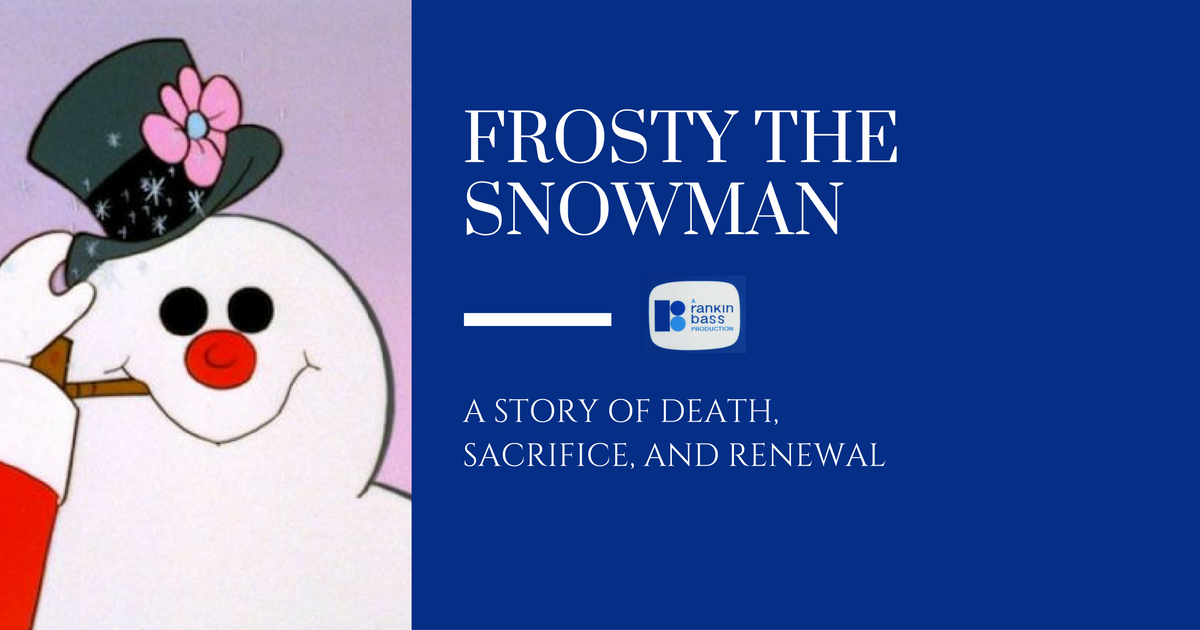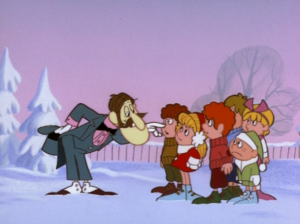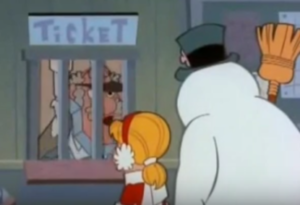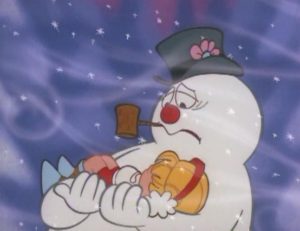
Ready to get back to rankin’ more Rankin-Bass with me? Good! I have to admit I’m excited today, as we’re back to covering what I consider to be an A-lister from the Rankin-Bass stable of films. These specials captured the majority of their success in adapting classic songs that were already considered a part of the Christmas canon. With their biggest success being the initial Rudolph the Red-Nosed Reindeer special, it seems fitting that their next milestone came in the form of another fairly non-denominational carol: Frosty the Snowman!

The first thing you notice about Frosty the Snowman is how clean and bright and beautiful everything looks. With an animation style that intentionally mimicked the look of a Christmas card, you get that sense of idyllic holiday wonder pretty much immediately. In many ways, the animated Rankin-Bass specials have a greater sense of production value than their stop-motion counterparts. Its unsurprising considering it was animated by Mushi Production, a company founded by Osamu Tezuka, considered by many to be the godfather of manga. Frosty the Snowman obviously benefits from this wealth of international talent, and the end result is a special that is clearly timelessly beautiful.
Hosted by Jimmy Durante in his final leading role, it’s also clear that the grim spectre of death hangs heavy on Frosty the Snowman. After all, what are snowmen if not omens of death? Of all of childhood’s playthings, the snowman is the most temporary. No matter how much work you put into creating the ideal creation, spring is going to come, and the snowman is going to die. The parent outlives its child. Durante walks around the scenes of Frosty the Snowman as an unseen spectre, seemingly playing his already departed self as he haunts the scenes that play out like a Ghost of Christmas Past.
Yet there’s work to be done in making this story function. Rudolph the Red-Nosed Reindeer had a built in narrative of overcoming oppression. Little Drummer Boy at least gave you a goal. Frosty the Snowman, as a song, pretty much only told you that the snowman came to life and had fun. Rankin-Bass needed to create a villain to put Frosty up against, and this time he would need to be central to the plot. Professor Hinkle fulfils this role beautifully. His presence feels organic, not only providing a villain but exploring the origin of the magic hat. Hocus Pocus, the rabbit, is less necessary, but provides a nice sidekick for this villain to play off of. “I’ll be a magician millionaire!” he yells upon discovery of the hat’s true properties, prioritising money and the pursuit of notoriety over the human condition. Frosty is more like Data in this regard, an object that eschews all else in his dreams of being a man.

Frosty the Snowman begins with six kids in a contemporary setting as they finish their last day of school before the Christmas break, including two redheaded boys. There are actually a lot of redheaded citizens of this town, a trend that will continue throughout all of the Rankin-Bass specials in a way that’s super obvious for someone who’s decided to watch all of them within the timespan of a week. Of course, even in a sea of redheads, we all know it’s only the blonde haired white girl who matters. Even as everyone else offers suggestions for names, it’s Karen who clearly takes the lead.
As an archetype, Karen is a true innocent. A natural born leader, she’s the only child who really gets any character development throughout the story. With Hinkle’s patronising scoff of “don’t talk back to your elders. Silly, silly, silly…” you know she will at one point stand up to this authority, but it’s also inevitable that she’s going to be broken by the events to come.
Durante goes on a bit of a tangent here. The hat didn’t belong to the children. That must be made clear. Hocus Pocus was entirely in the right. Like, okay, but he threw the hat away.
Yet here’s where the story meets its first non-Hinkle related obstacle. As Frosty observes a thermometer get increasingly red, his mortality comes into question. How will a snowman survive when the weather gets warmer? The sense of fear in his voice is palpable. He doesn’t want to die. It’s decided then and there to buy Frosty a train ticket to the North Pole where it will stay cold all year long.

Making their march through the town square, the gang run into the inimitable Paul Frees as an Irish cop. Paul Frees is the John Ratzenberger of Rankin-Bass and gets severely underpredicted for his accomplishments. This cop is a standout performance in an already formidable special. Also standout is this crazy ticket man at the train station. In a rather efficient bit of business which, looking at as from a generation that’s never had to be an adult without a computer, absolutely blows my mind. He organizes their North Pole trip for $3000.04. This is a problem as obviously neither Frosty nor Karen carry any money.
Out of the city, a new dimension of danger is added to the mix. Karen and Frosty are on their own, and while Frosty was in danger of melting, Karen is now in danger of freezing.

I am endlessly impressed at Rankin-Bass’ ability to expand on a grain of an idea to tell a full and complex story. The key to any good story is conflict. External conflicts are great for making the plot chug along, but it’s internal conflicts that cause a character to actually change and grow, the kind of storytelling that ends up being the most emotionally satisfying. That internal conflict for Frosty comes from the fact that he’s made of snow. Karen and Frosty are ying and yang to each other and, truly, only one can survive by the end of the film. Frosty has to make a fire to keep Karen warm, but he keeps his distance. This is fantastic, as it leaves some room for the stakes to be increased later on.
And after some antics with a “Belly-whopper”, boy do they increase quickly. Frosty finds a greenhouse used to grow Christmas poinsettias and takes the vulnerable Karen back inside. In a heartbreaking scene, Frosty puts himself at maximum risk for Karen’s sake. When Hinkle locks them both in, Frosty is presented with a choice. It would be nothing, here, to smash the glass of the greenhouse and walk back into the cold, but Karen would again be in danger. He is literally sacrificing himself to ensure Karen survives. This is character development at its finest, and it’s no wonder so many kids cried when they saw that puddle on the ground.
Let’s linger here, as we did with Rudolph, on potentially the most important moment of the whole special: Frosty dies.

It skips over making us watch, but Karen saw it all. Santa has to show up to hold our hand through the difficult part of the script. We enter the greenhouse through Santa’s perspective to see her crying over a beautifully heartbreakingly rendered puddle. Durante slows down the tempo of the song here, transforming the jolly Frosty the Snowman into a ballad of mournful remembrance. It uses nostalgia and familiarity with the song to create a moving moment. I’d argue this scene plays even better in 2016 than it did in 1969, as Frosty the Snowman has now become such an enduring and well-known tune because of this special that this mournful lamentation tugs at your heartstrings all the more firmly.
Santa’s steadfast assurance helps us understand and move past death. This is an almost Narnian version of Santa, wise and magical with unfathomable power. Professor Hinkle’s heel-face-turn is understandable in the presence of Santa. Think back to so many other Christmas movies that use this scene. Judge Reinhold blowing his weiner whistle. It’s one of my favourite uses of Santa as a mythical character.
We’re assured that Frosty comes back every year. Though note that what we see during the credits is only an echo of earlier scenes, possibly even reused footage. There’s a filter over the footage that obscures it. Is Frosty really coming back year after year, or are we simply using this time of year to nostalgically remember him, in the way that he’ll live forever in our hearts?
I’m placing this one just underneath Rudolph the Red-Nosed Reindeer in my chart. Both are A+ stories that excel in both narrative construct and subtextual analysis, but I think Rudolph gets to keep the top spot if only for getting there first. Had Frosty been allotted the same running time, it might have overtaken it.
1. Rudolph the Red-Nosed Reindeer
2. Frosty the Snowman
3. The Little Drummer Boy
Like Frosty, I’ll be back again someday. Most likely tomorrow. And when I come back? Well, you better not pout, you better not cry, because Santa Claus Is Comin’ To Town!




![[PODCAST] FANBOY POWER HOUR EPISODE 272: FURTHER DISCUSSION OF INTERSTELLAR CONFLICT](https://geekd-out.com/wp-content/uploads/2020/01/Fanboy-Banner-150x150.jpg)